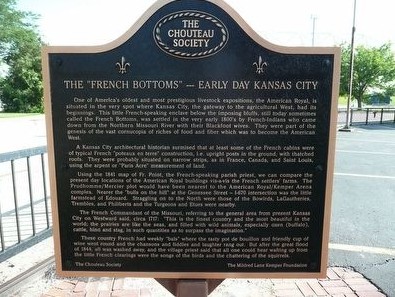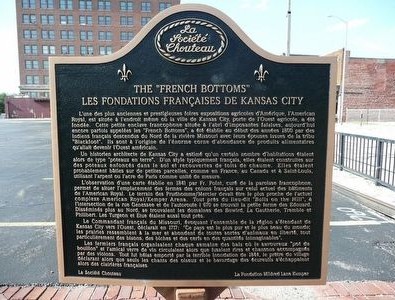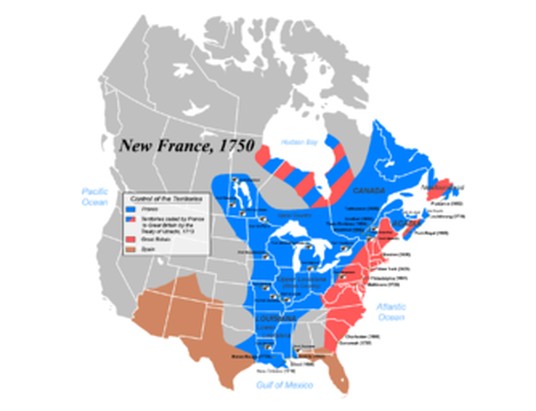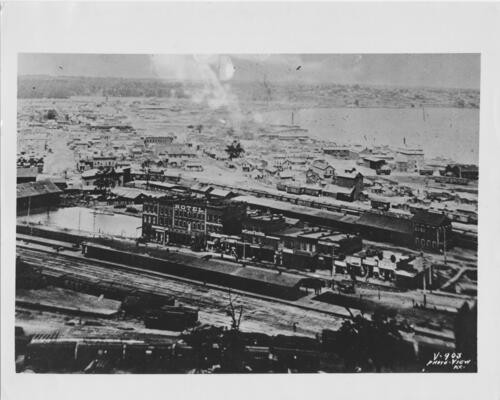The "French Bottoms" - Early Day Kansas City Historical Marker
Introduction
Text-to-speech Audio
Commonly referred to as the West Bottoms, the French Bottoms was the general location of the French speaking village of Chez les Canses, the first permanent White settlement in the modern day Kansas City. First settled in 1799, the village only stood for a few decades before being washed away by a flood in 1844. Into the late 1800s, this area became a commercial hub with the newly built Union Depot and stockyards. This historical marker was removed in 2018 for new construction at this location and is awaiting a permanent home.
Images
English side of the marker, courtesy of Michael W. Kruse

French side of the marker, courtesy of Michael W. Kruse

Loose map of the extent of French colonial control in North America in 1750

The West Bottoms c.1870. Courtesy of Missouri Valley Special Collections, Kansas City Public Library, Kansas City, Missouri.

Backstory and Context
Text-to-speech Audio
Missouri was a long time frontier for the French monarchy as it looked to expand its colonial empire west beyond the Mississippi River. Many explorers and traders were sent by the French up the Missouri River to establish presence and trade with Native peoples and the Spanish in Santa Fe. Though several made it past the confluence of the Missouri and Kansas Rivers where Kansas City stands today, no permanent settlement for the French crown was founded west of central Missouri.
The French Commandant of the Missouri mentioned in the marker is Étienne de Veniard Sieur de Bourgmont. He used Fort Orleans near the mouth of Grand River in central Missouri as his headquarters until his return to France in 1725. Bourgmont regularly traveled to and beyond the confluence of the Missouri and Kansas Rivers. His expeditions were heavily influential for the creation of the Santa Fe trail.
The settlement mentioned in the marker as being founded in the early 1800’s was Chez les Canses, which was first settled in 1799. These French settlers found themselves to be apart from the United States in wake of the Louisiana Purchase in 1803. Inhabitants of the village were involved in farming and some level of the fur trade with Francois Chouteau’s trading post that was founded in 1821. Nothing is left of the original village after its destruction by flooding in 1844.
The text of this historical marker reads as follows:
One of America’s oldest and most prestigious livestock expositions, the American Royal, is situated in the very spot where Kansas City, the gateway to the agricultural West, had its beginnings. This little French-speaking enclave below the imposing bluffs, still today sometimes called the French Bottoms, was settled in the very early 1800’s by French-Indians who came down from the Northern Missouri River with their Blackfoot wives. They were part of the genesis of the vast cornucopia of riches of food and fiber which was to become the American West.
A Kansas City architectural historian surmised that at least some of the French cabins were of typical French “poteaux en terre” construction, i.e., upright posts in the ground, with thatched roofs. They were probably situated on narrow strips, as in France, Canada, and Saint Louis, using the arpent of “Paris Acre” measurement of land.
Using the 1841 map of Fr. Point, the French-speaking parish priest, we can compare the present day locations of the American Royal buildings vis-à-vis the French settles’ farms. The Prudhomme/Mercier plot would have been nearest to the American Royal/Kemper Arena complex. Nearer the “bulls on the hill” at Genessee Street – I-670 intersection was the little farmstead of Edouard. Straggling on to the North were those of the Bowirds, LaGautheries, Trembles, and Philberts and the Tugeons and Etues were nearby.
The French Commandant of the Missouri, referring to the general area from present Kansas City on Westward said, circa 1717: “This is the finest country and the most beautiful in the world; the prairies are like the seas, and filled with wild animals, especially oxen (buffalo), cattle, hind and stag, in such quantities as to surpass the imagination.”
These country French had week “bals” where the tasty pot de boullion and friendly cup of wine went round and the chansons and fiddles and laughter rang out. But after the great flood of 1844, all was washed away, and the village priest said that all one could hear wafting up from the little French clearings were the songs of the birds and the chattering of the squirrels.
Sources
The French Bottoms - Early Day Kansas City, The Historical Marker Database . Accessed July 28th, 2022. https://www.hmdb.org/m.asp?m=86358.
Norall, Frank. Bourgmont: Explorer of the Missouri, 1698-1725. Alberta. The University of Alberta Press, 1988.
Hoig, Stan. The Chouteaus First Family of the Fur Trade. University of New Mexico Press, 2008.
Chez les Canses: Chouteau's Town Before Kansas City, The New Santa Fe Trailer. July 31st, 2019. Accessed August 8th, 2022. https://newsantafetrailer.blogspot.com/2019/07/chez-les-canses-chouteaus-town-before.html.
https://www.hmdb.org/m.asp?m=86358
https://www.hmdb.org/m.asp?m=86358
http://dsullivanadaircountyr1.weebly.com/missouri-unit-four-arrival-of-europeans.html
https://kchistory.org/image/west-bottoms-37
